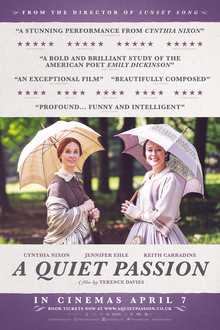| A Quiet Passion |
|---|
 |
by Peter J. O’Connell
A Quiet Passion. Released:
April 14. Runtime: 125 mins. MPAA Rating: PG-13 for thematic elements,
disturbing images, and brief suggestive material.
Emily Dickinson always has been a challenging figure. She
challenged her family, who loved her dearly—and whom she loved—but found her
“difficult.” She challenged the townsfolk of Amherst, Massachusetts—where she
was born (1830), lived her entire life, and died (1886)—who witnessed the
transformation of a high-spirited young woman, who might have become the “Belle
of Amherst,” into “Myth Dickinson,” the reclusive woman in white who wrote from
3 a.m. to 6 a.m. in her room, did not leave the family home, and spoke to
visitors from the top of her home’s staircase rather than face to face.
And she challenged the literary establishment. She wrote
some 1,800 poems, but only ten were published in her lifetime. Yet when her
poems began to be published a few years after her death, they proved popular
with readers but were put out in versions changed by her executors and editors,
who did not care for—or even understand—some of her idiosyncratic, yet
meaningful, wording, capitalization, and punctuation. It took until the 1950s
for accurate and complete versions of her work to appear. But from 1890 to the
present, Dickinson’s work never has been out of print.
The literary establishment for several decades had
difficulty coming to terms with Dickinson. For example, in 1892 Thomas Bailey
Aldrich, a popular author of the time, wrote: “. . . an eccentric, dreamy,
half-educated recluse in an out-of-the-way New England village (or anywhere
else) cannot with impunity set at defiance the laws of gravitation and
grammar.” But opinion had changed by 1937, when noted critic R.P. Blackmur
wrote: “Her gift for words and the cultural predicament of her times drove her
to poetry instead of antimacassars . . .. She came at the right time for one
kind of poetry: the poetry of sophisticated, eccentric vision.”
Women took up Dickinson’s cause. Poet Adrienne Rich wrote in
1976 that Dickinson “carefully selected her society and controlled the disposal
of her time . . . she was determined to survive, to use her powers, to practice
necessary economics.”
In 1994 uber-critic Harold Bloom placed Dickinson among the
26 central writers of the canon of Western Civilization.
Now in A Quiet Passion,
writer/director Terence Davies takes up the challenge pf putting Emily
Dickinson’s life on the screen. In the film we first encounter Emily as a
student at Mt. Holyoke Female Seminary. (In the film’s early scenes, Emily is
played—well—by Emma Bell; in later scenes, by Cynthia Nixon—superbly.) Emily
resists the evangelical pressures at the school and returns to her family home.
Her father (Keith Carradine) allows his son and two daughters some
independence—but only up to a certain point. Cross that line, and he defends
“propriety” as any stern Victorian patriarch would. Coming to terms with this
mixed heritage may have been the challenge to Emily Dickinson’s consciousness
that made her such a challenging figure to others.
The first part of A Quiet
Passion has an almost Jane Austen-like quality as Emily, her sister, Vinnie
(Jennifer Ehle), and a friend, Vryling Buffam (Catherine Bailey), walk in sunny
gardens and engage in witty repartee, exchanging bon mots, and sometimes, in
Emily’s case, firing off the mid-19th century equivalent of
one-liners and insult comic-type putdowns of pretentious figures. There is also
the hint of a crush on a young minister, but he is married.
As time goes on, however, the film’s tone becomes darker. In
the larger world, the Civil War rages; in the domestic world, friends and
family pass away. Emily devotes herself more and more to her poetry; outside scenes
are no more. Brown and gray and shadows begin to predominate in the excellent
cinematography. This excellence is also manifested in the careful camera
movements, which convey a sense of constriction, though not of suffocation.
As Emily enters her “Myth Dickinson” phase, it is as if she
deals with the cultural constriction hampering women and creative folk by
voluntarily making an extreme version of it into her personal lifestyle. In
some ways she is like the eponymous character in Melville’s “Bartleby the
Scrivener: A Story of Wall Street,” who “prefers not to” accept the role of
worker drone that he has been assigned—or to leave the workplace where he has
been assigned it. Bartleby’s revolt was a quiet one, but a revolt nonetheless.
So it was with Emily Dickinson, a quiet, yet passionate, revolt.
As was said at the beginning of this review, Emily Dickinson
is a challenging figure to portray. But Cynthia Nixon is more than equal to
that challenge. Her expertly modulated performance captures the loving essence
of Dickinson, her use of imagination to maintain her independence, and her
laser-like insights into the human condition, whether in an “out-of-the-way New
England village (or anywhere else).”
A Quiet Passion
uses read-overs by Nixon of some of Dickinson’s poems to moving effect. Curiously,
there is one not read that seems to express well the Emily that we see in
Davies’ well-directed film. Here is part of it:
The soul selects her own society,
Then shuts the door.
To her divine majority
Present no more . . .
I’ve known her . . .
Then close the valves of her attention
Like stone.



